Managing People Online Exam: Leadership and Performance
VerifiedAdded on 2022/12/29
|11
|2715
|317
Quiz and Exam
AI Summary
This document presents a comprehensive solution to a Managing People online exam, covering various aspects of leadership and performance management. Section A addresses multiple-choice questions on topics like employee engagement, discrimination, job analysis, CSR, computational thinking, pay gaps, human capital theory, total rewards, and financial and customer perspectives. Section B delves into performance management strategies, including 360-degree feedback, management by objectives, frequent performance feedback, and reward systems. It also provides recommendations for managing performance using behaviorally anchored rating scales and psychological appraisals. Furthermore, the document analyzes the evolution of leadership in engaging teams, focusing on two leadership styles: Complex Adaptive Leadership and Leader Member Exchange theory, exploring their roles in fostering team engagement and achieving organizational goals. The solution provides detailed answers and insights to help students understand key concepts and prepare for their exams.

Managing People (Online
Exam)
Exam)
Paraphrase This Document
Need a fresh take? Get an instant paraphrase of this document with our AI Paraphraser
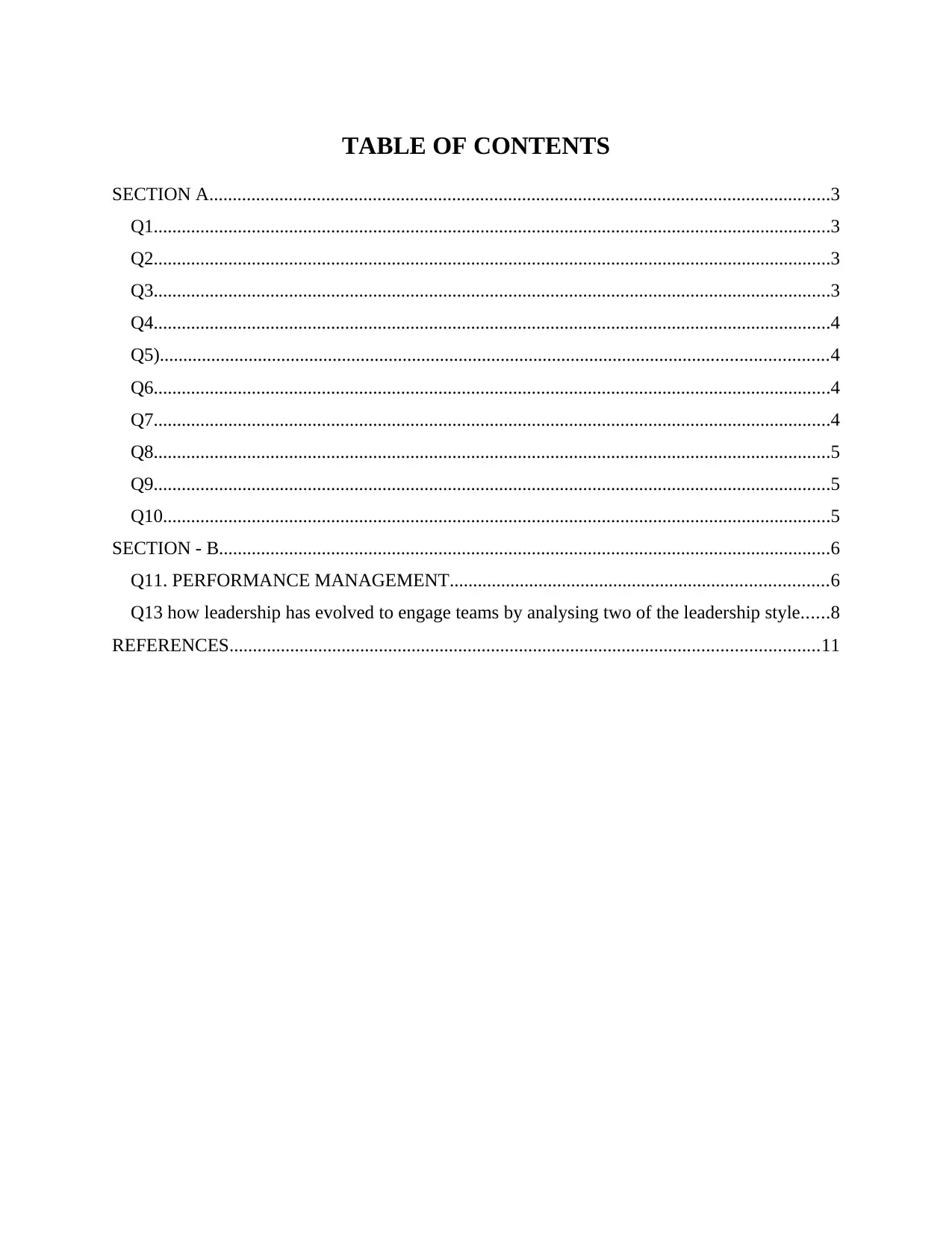
TABLE OF CONTENTS
SECTION A.....................................................................................................................................3
Q1.................................................................................................................................................3
Q2.................................................................................................................................................3
Q3.................................................................................................................................................3
Q4.................................................................................................................................................4
Q5)...............................................................................................................................................4
Q6.................................................................................................................................................4
Q7.................................................................................................................................................4
Q8.................................................................................................................................................5
Q9.................................................................................................................................................5
Q10...............................................................................................................................................5
SECTION - B...................................................................................................................................6
Q11. PERFORMANCE MANAGEMENT.................................................................................6
Q13 how leadership has evolved to engage teams by analysing two of the leadership style......8
REFERENCES..............................................................................................................................11
SECTION A.....................................................................................................................................3
Q1.................................................................................................................................................3
Q2.................................................................................................................................................3
Q3.................................................................................................................................................3
Q4.................................................................................................................................................4
Q5)...............................................................................................................................................4
Q6.................................................................................................................................................4
Q7.................................................................................................................................................4
Q8.................................................................................................................................................5
Q9.................................................................................................................................................5
Q10...............................................................................................................................................5
SECTION - B...................................................................................................................................6
Q11. PERFORMANCE MANAGEMENT.................................................................................6
Q13 how leadership has evolved to engage teams by analysing two of the leadership style......8
REFERENCES..............................................................................................................................11
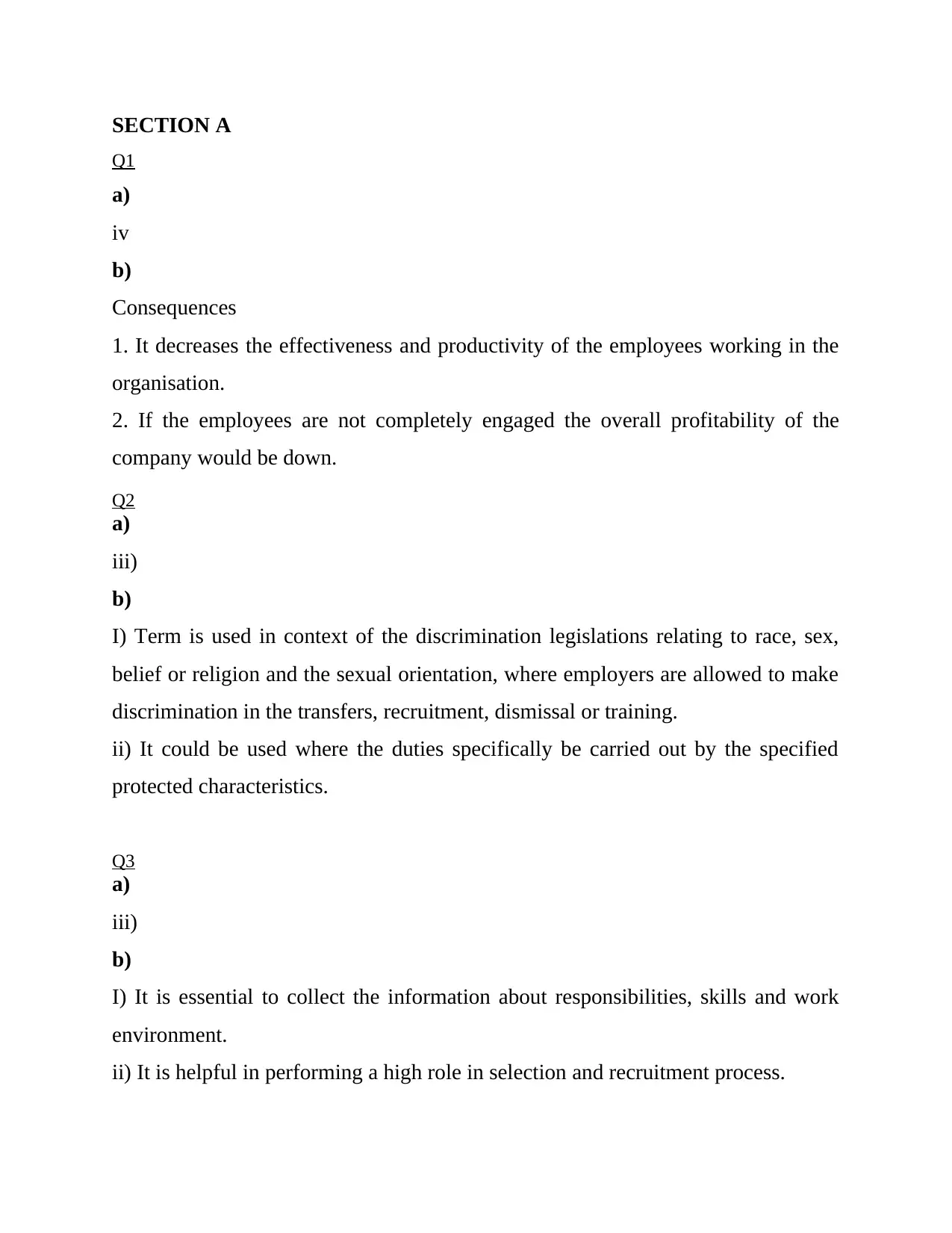
SECTION A
Q1
a)
iv
b)
Consequences
1. It decreases the effectiveness and productivity of the employees working in the
organisation.
2. If the employees are not completely engaged the overall profitability of the
company would be down.
Q2
a)
iii)
b)
I) Term is used in context of the discrimination legislations relating to race, sex,
belief or religion and the sexual orientation, where employers are allowed to make
discrimination in the transfers, recruitment, dismissal or training.
ii) It could be used where the duties specifically be carried out by the specified
protected characteristics.
Q3
a)
iii)
b)
I) It is essential to collect the information about responsibilities, skills and work
environment.
ii) It is helpful in performing a high role in selection and recruitment process.
Q1
a)
iv
b)
Consequences
1. It decreases the effectiveness and productivity of the employees working in the
organisation.
2. If the employees are not completely engaged the overall profitability of the
company would be down.
Q2
a)
iii)
b)
I) Term is used in context of the discrimination legislations relating to race, sex,
belief or religion and the sexual orientation, where employers are allowed to make
discrimination in the transfers, recruitment, dismissal or training.
ii) It could be used where the duties specifically be carried out by the specified
protected characteristics.
Q3
a)
iii)
b)
I) It is essential to collect the information about responsibilities, skills and work
environment.
ii) It is helpful in performing a high role in selection and recruitment process.
⊘ This is a preview!⊘
Do you want full access?
Subscribe today to unlock all pages.

Trusted by 1+ million students worldwide
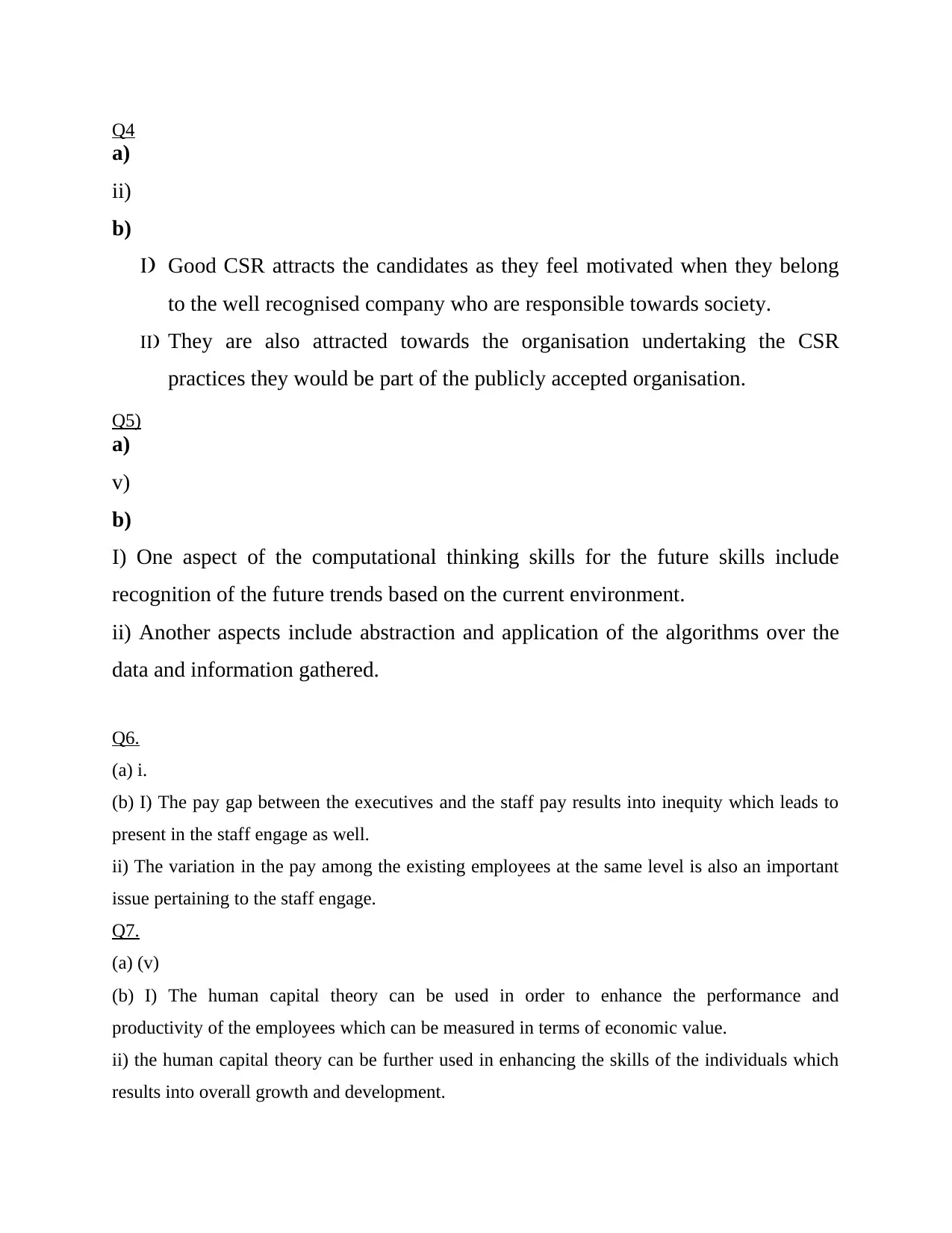
Q4
a)
ii)
b)
I) Good CSR attracts the candidates as they feel motivated when they belong
to the well recognised company who are responsible towards society.
II) They are also attracted towards the organisation undertaking the CSR
practices they would be part of the publicly accepted organisation.
Q5)
a)
v)
b)
I) One aspect of the computational thinking skills for the future skills include
recognition of the future trends based on the current environment.
ii) Another aspects include abstraction and application of the algorithms over the
data and information gathered.
Q6.
(a) i.
(b) I) The pay gap between the executives and the staff pay results into inequity which leads to
present in the staff engage as well.
ii) The variation in the pay among the existing employees at the same level is also an important
issue pertaining to the staff engage.
Q7.
(a) (v)
(b) I) The human capital theory can be used in order to enhance the performance and
productivity of the employees which can be measured in terms of economic value.
ii) the human capital theory can be further used in enhancing the skills of the individuals which
results into overall growth and development.
a)
ii)
b)
I) Good CSR attracts the candidates as they feel motivated when they belong
to the well recognised company who are responsible towards society.
II) They are also attracted towards the organisation undertaking the CSR
practices they would be part of the publicly accepted organisation.
Q5)
a)
v)
b)
I) One aspect of the computational thinking skills for the future skills include
recognition of the future trends based on the current environment.
ii) Another aspects include abstraction and application of the algorithms over the
data and information gathered.
Q6.
(a) i.
(b) I) The pay gap between the executives and the staff pay results into inequity which leads to
present in the staff engage as well.
ii) The variation in the pay among the existing employees at the same level is also an important
issue pertaining to the staff engage.
Q7.
(a) (v)
(b) I) The human capital theory can be used in order to enhance the performance and
productivity of the employees which can be measured in terms of economic value.
ii) the human capital theory can be further used in enhancing the skills of the individuals which
results into overall growth and development.
Paraphrase This Document
Need a fresh take? Get an instant paraphrase of this document with our AI Paraphraser

Q8.
(a) (iv)
(b) I) The total rewards includes various elements like flexible benefits, freedom and autonomy,
opportunity for personal growth, raising matter of concerns etc.
ii) The total rewards focusses on the way how the employees are retained and engaged to meet
business objectives.
Q9.
(a) (I)
(b)
I) Finance
This evaluates the financial health and performance of the company.
ii) Customer perspective
This evaluates customer service and satisfaction level.
Q10.
(a) (i)
(b) I) Top 20% - offering more to the organization and would receive grater rewards.
ii) Players under 10% are the underperforming and are also not aligned with the business
objectives.
(a) (iv)
(b) I) The total rewards includes various elements like flexible benefits, freedom and autonomy,
opportunity for personal growth, raising matter of concerns etc.
ii) The total rewards focusses on the way how the employees are retained and engaged to meet
business objectives.
Q9.
(a) (I)
(b)
I) Finance
This evaluates the financial health and performance of the company.
ii) Customer perspective
This evaluates customer service and satisfaction level.
Q10.
(a) (i)
(b) I) Top 20% - offering more to the organization and would receive grater rewards.
ii) Players under 10% are the underperforming and are also not aligned with the business
objectives.
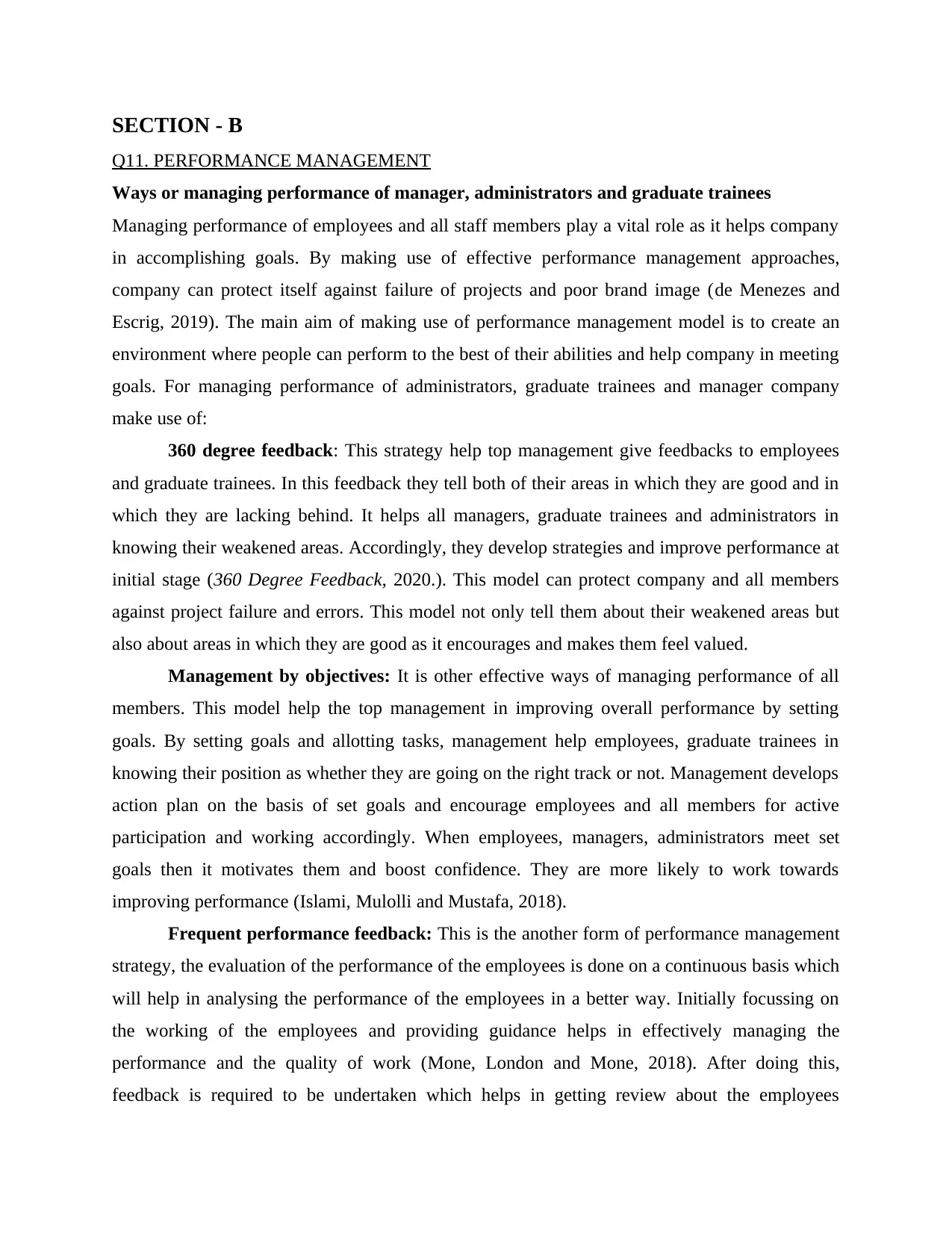
SECTION - B
Q11. PERFORMANCE MANAGEMENT
Ways or managing performance of manager, administrators and graduate trainees
Managing performance of employees and all staff members play a vital role as it helps company
in accomplishing goals. By making use of effective performance management approaches,
company can protect itself against failure of projects and poor brand image (de Menezes and
Escrig, 2019). The main aim of making use of performance management model is to create an
environment where people can perform to the best of their abilities and help company in meeting
goals. For managing performance of administrators, graduate trainees and manager company
make use of:
360 degree feedback: This strategy help top management give feedbacks to employees
and graduate trainees. In this feedback they tell both of their areas in which they are good and in
which they are lacking behind. It helps all managers, graduate trainees and administrators in
knowing their weakened areas. Accordingly, they develop strategies and improve performance at
initial stage (360 Degree Feedback, 2020.). This model can protect company and all members
against project failure and errors. This model not only tell them about their weakened areas but
also about areas in which they are good as it encourages and makes them feel valued.
Management by objectives: It is other effective ways of managing performance of all
members. This model help the top management in improving overall performance by setting
goals. By setting goals and allotting tasks, management help employees, graduate trainees in
knowing their position as whether they are going on the right track or not. Management develops
action plan on the basis of set goals and encourage employees and all members for active
participation and working accordingly. When employees, managers, administrators meet set
goals then it motivates them and boost confidence. They are more likely to work towards
improving performance (Islami, Mulolli and Mustafa, 2018).
Frequent performance feedback: This is the another form of performance management
strategy, the evaluation of the performance of the employees is done on a continuous basis which
will help in analysing the performance of the employees in a better way. Initially focussing on
the working of the employees and providing guidance helps in effectively managing the
performance and the quality of work (Mone, London and Mone, 2018). After doing this,
feedback is required to be undertaken which helps in getting review about the employees
Q11. PERFORMANCE MANAGEMENT
Ways or managing performance of manager, administrators and graduate trainees
Managing performance of employees and all staff members play a vital role as it helps company
in accomplishing goals. By making use of effective performance management approaches,
company can protect itself against failure of projects and poor brand image (de Menezes and
Escrig, 2019). The main aim of making use of performance management model is to create an
environment where people can perform to the best of their abilities and help company in meeting
goals. For managing performance of administrators, graduate trainees and manager company
make use of:
360 degree feedback: This strategy help top management give feedbacks to employees
and graduate trainees. In this feedback they tell both of their areas in which they are good and in
which they are lacking behind. It helps all managers, graduate trainees and administrators in
knowing their weakened areas. Accordingly, they develop strategies and improve performance at
initial stage (360 Degree Feedback, 2020.). This model can protect company and all members
against project failure and errors. This model not only tell them about their weakened areas but
also about areas in which they are good as it encourages and makes them feel valued.
Management by objectives: It is other effective ways of managing performance of all
members. This model help the top management in improving overall performance by setting
goals. By setting goals and allotting tasks, management help employees, graduate trainees in
knowing their position as whether they are going on the right track or not. Management develops
action plan on the basis of set goals and encourage employees and all members for active
participation and working accordingly. When employees, managers, administrators meet set
goals then it motivates them and boost confidence. They are more likely to work towards
improving performance (Islami, Mulolli and Mustafa, 2018).
Frequent performance feedback: This is the another form of performance management
strategy, the evaluation of the performance of the employees is done on a continuous basis which
will help in analysing the performance of the employees in a better way. Initially focussing on
the working of the employees and providing guidance helps in effectively managing the
performance and the quality of work (Mone, London and Mone, 2018). After doing this,
feedback is required to be undertaken which helps in getting review about the employees
⊘ This is a preview!⊘
Do you want full access?
Subscribe today to unlock all pages.

Trusted by 1+ million students worldwide

thinking pertaining to the employers and the training provided. In this way, the management gets
an idea about the employee's perspective so that required changes can be made through the way
of effectively meeting with the employee's requirement. This results into enhancing and
improving the performance and productivity of the employees. On gathering feedback from the
employees on a regular or in aperiodic way helps in timely meeting up the employees needs and
resolving the issues that the employees are facing. This is also an effective strategy which results
into managing the performance of the employees in a better way. This strategy is mostly used by
all the organizations as it ensures success and a positive outcome.
Implementing rewards: Another way for guaranteeing better performance and
effectively handling the performance is through the way of implementation of the rewards and
practising the pre-emptive management. Employees are already well aware about the
organization's expectation from them and therefore, there is no guesswork in the workplace. But
in order to encourage the employees to further enhance the performance meeting the targets on
time can be done through the introduction of the proper reward system (Nazir and Islam, 2017).
The reward system works as a motivator for the employees which consequently leads to increase
in the over achieving the target along with meeting with the quality. By putting attractive
rewards, incentives and promotions in place helps in further improvement in the performance of
the employees. This strategy is being implemented by many and is widely used as it definitely
provides desired outcome which turn out to be beneficial for the organization.
Recommendations for managing performance
In the regards to managing performance of graduate trainees and administrators it can be
recommended that company should focus on using behaviourally anchored rating scale (BARS).
This model helps management in comparing performance of their employees with set specific
behavioural examples. Performance level on this scale shows common behaviours that
employees posses and differences between set behavioural and the exact performance. On the
basis of differences management can take appropriate actions for improving their performance.
Physiological appraisal: In addition, Psychological appraisals can also help company in
improving as well as managing performance of graduate trainees and administrators. According
to this strategy, management requires focusing on employees' future performance rather than
their past work. It encourages employees and boost their confidence and can also help them out
an idea about the employee's perspective so that required changes can be made through the way
of effectively meeting with the employee's requirement. This results into enhancing and
improving the performance and productivity of the employees. On gathering feedback from the
employees on a regular or in aperiodic way helps in timely meeting up the employees needs and
resolving the issues that the employees are facing. This is also an effective strategy which results
into managing the performance of the employees in a better way. This strategy is mostly used by
all the organizations as it ensures success and a positive outcome.
Implementing rewards: Another way for guaranteeing better performance and
effectively handling the performance is through the way of implementation of the rewards and
practising the pre-emptive management. Employees are already well aware about the
organization's expectation from them and therefore, there is no guesswork in the workplace. But
in order to encourage the employees to further enhance the performance meeting the targets on
time can be done through the introduction of the proper reward system (Nazir and Islam, 2017).
The reward system works as a motivator for the employees which consequently leads to increase
in the over achieving the target along with meeting with the quality. By putting attractive
rewards, incentives and promotions in place helps in further improvement in the performance of
the employees. This strategy is being implemented by many and is widely used as it definitely
provides desired outcome which turn out to be beneficial for the organization.
Recommendations for managing performance
In the regards to managing performance of graduate trainees and administrators it can be
recommended that company should focus on using behaviourally anchored rating scale (BARS).
This model helps management in comparing performance of their employees with set specific
behavioural examples. Performance level on this scale shows common behaviours that
employees posses and differences between set behavioural and the exact performance. On the
basis of differences management can take appropriate actions for improving their performance.
Physiological appraisal: In addition, Psychological appraisals can also help company in
improving as well as managing performance of graduate trainees and administrators. According
to this strategy, management requires focusing on employees' future performance rather than
their past work. It encourages employees and boost their confidence and can also help them out
Paraphrase This Document
Need a fresh take? Get an instant paraphrase of this document with our AI Paraphraser
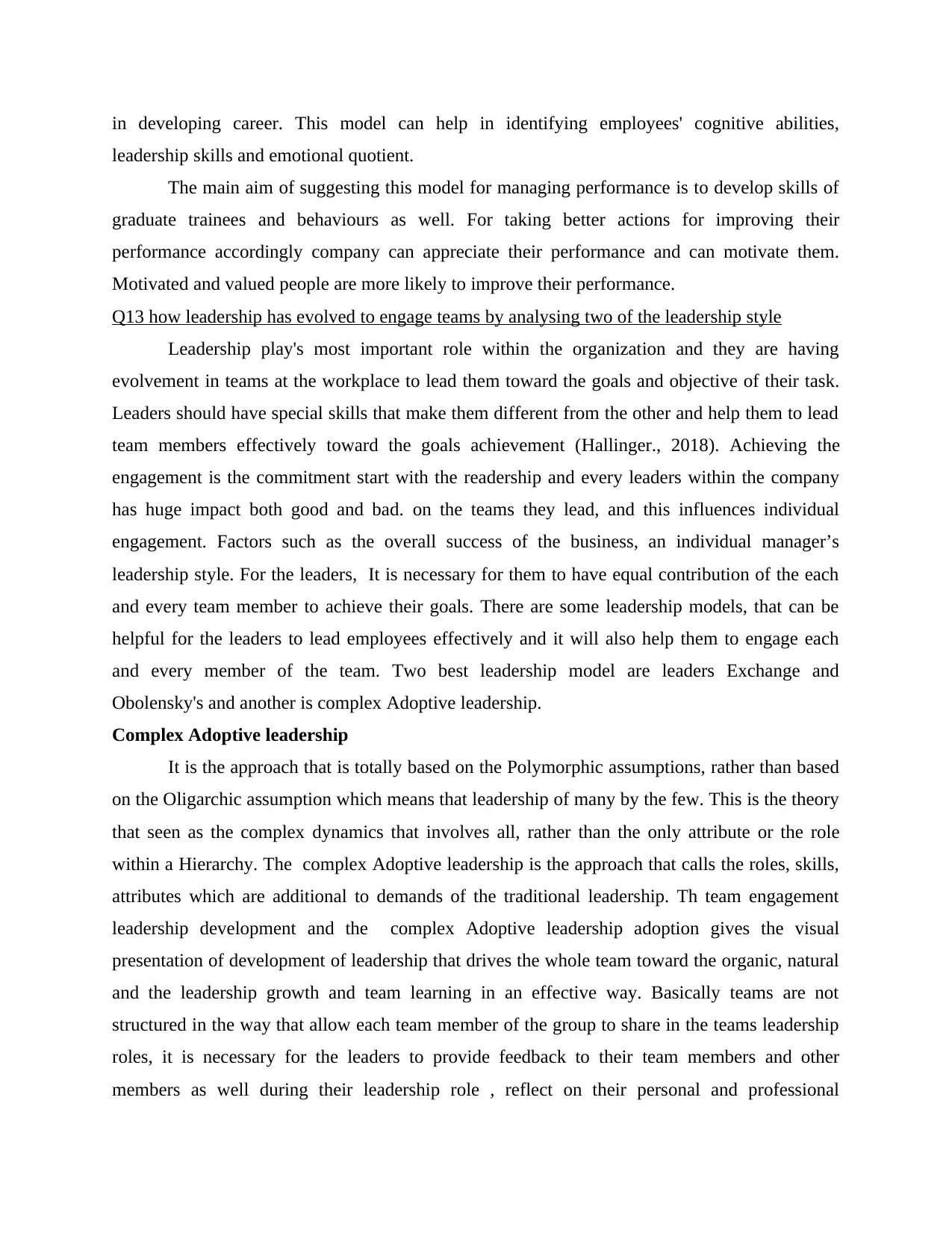
in developing career. This model can help in identifying employees' cognitive abilities,
leadership skills and emotional quotient.
The main aim of suggesting this model for managing performance is to develop skills of
graduate trainees and behaviours as well. For taking better actions for improving their
performance accordingly company can appreciate their performance and can motivate them.
Motivated and valued people are more likely to improve their performance.
Q13 how leadership has evolved to engage teams by analysing two of the leadership style
Leadership play's most important role within the organization and they are having
evolvement in teams at the workplace to lead them toward the goals and objective of their task.
Leaders should have special skills that make them different from the other and help them to lead
team members effectively toward the goals achievement (Hallinger., 2018). Achieving the
engagement is the commitment start with the readership and every leaders within the company
has huge impact both good and bad. on the teams they lead, and this influences individual
engagement. Factors such as the overall success of the business, an individual manager’s
leadership style. For the leaders, It is necessary for them to have equal contribution of the each
and every team member to achieve their goals. There are some leadership models, that can be
helpful for the leaders to lead employees effectively and it will also help them to engage each
and every member of the team. Two best leadership model are leaders Exchange and
Obolensky's and another is complex Adoptive leadership.
Complex Adoptive leadership
It is the approach that is totally based on the Polymorphic assumptions, rather than based
on the Oligarchic assumption which means that leadership of many by the few. This is the theory
that seen as the complex dynamics that involves all, rather than the only attribute or the role
within a Hierarchy. The complex Adoptive leadership is the approach that calls the roles, skills,
attributes which are additional to demands of the traditional leadership. Th team engagement
leadership development and the complex Adoptive leadership adoption gives the visual
presentation of development of leadership that drives the whole team toward the organic, natural
and the leadership growth and team learning in an effective way. Basically teams are not
structured in the way that allow each team member of the group to share in the teams leadership
roles, it is necessary for the leaders to provide feedback to their team members and other
members as well during their leadership role , reflect on their personal and professional
leadership skills and emotional quotient.
The main aim of suggesting this model for managing performance is to develop skills of
graduate trainees and behaviours as well. For taking better actions for improving their
performance accordingly company can appreciate their performance and can motivate them.
Motivated and valued people are more likely to improve their performance.
Q13 how leadership has evolved to engage teams by analysing two of the leadership style
Leadership play's most important role within the organization and they are having
evolvement in teams at the workplace to lead them toward the goals and objective of their task.
Leaders should have special skills that make them different from the other and help them to lead
team members effectively toward the goals achievement (Hallinger., 2018). Achieving the
engagement is the commitment start with the readership and every leaders within the company
has huge impact both good and bad. on the teams they lead, and this influences individual
engagement. Factors such as the overall success of the business, an individual manager’s
leadership style. For the leaders, It is necessary for them to have equal contribution of the each
and every team member to achieve their goals. There are some leadership models, that can be
helpful for the leaders to lead employees effectively and it will also help them to engage each
and every member of the team. Two best leadership model are leaders Exchange and
Obolensky's and another is complex Adoptive leadership.
Complex Adoptive leadership
It is the approach that is totally based on the Polymorphic assumptions, rather than based
on the Oligarchic assumption which means that leadership of many by the few. This is the theory
that seen as the complex dynamics that involves all, rather than the only attribute or the role
within a Hierarchy. The complex Adoptive leadership is the approach that calls the roles, skills,
attributes which are additional to demands of the traditional leadership. Th team engagement
leadership development and the complex Adoptive leadership adoption gives the visual
presentation of development of leadership that drives the whole team toward the organic, natural
and the leadership growth and team learning in an effective way. Basically teams are not
structured in the way that allow each team member of the group to share in the teams leadership
roles, it is necessary for the leaders to provide feedback to their team members and other
members as well during their leadership role , reflect on their personal and professional

performance, so they can improve and team can achieve their task goals and help company to
achieve success within the market where they are operating their business, and they will able to
enhance their productivity as well (Oc., 2018). While typically for the team members to learn
from the other team members about their skills, and they can improve or new skills in
themselves. Teams can have only one leaders who will guide them and take them toward the
success but the complex Adoptive leadership is different and it can have more than one and
various leaders from the single team. Basically team members get equal chance to lead the team
and show their leadership skills and help company to achieve success by engaging each team
members with their leadership skills is they can achieve their task goals and get success within
the task.
Leader member exchange theory
The informal observations of leaders behaviour suggests that the actions of leaders are
not same towards the subordinates. Importance of the potential differences in this context is
brought under focus under focus leader member exchange model that is also called vertical dyad
linkage theory. It views leadership which consists of numbers of dyadic relationship that links
leader with follower. Quality of relationship is often reflected by degree of the loyalty, mutual
trust, respect, support and the obligations. As per theory, the leaders create different type of the
relationships with many groups of the subordinates (Moser, 2018). Among these group one is
favoured by leader. The members of such group receives more attention from leader and have the
access to organisational resources. In contrast the other subordinates tends to fall into out group
and these people are disfavoured by leader. They also receive less resources from the leaders.
They distinguish members of in and out group on basis of perceived similarity based on personal
characteristics like gender, age or personality. Followers are granted status of in-group if leader
believes candidate is competent for performing the job. Relationship between the followers and
leaders have different stages like role taking and role making.
Role taking occurs when new member join organisation, leader assesses abilities and talent of
member and then offers opportunities for demonstrating the capabilities. On the other in Role
making there is unstructured and informal negotiation on the work related matters take place
between member and leader. Member similar to leader are likely to grow. Betrayal by member
on this stage could result in being relegated to out-group. The model is exceptional theory of the
leadership unlike other models which concentrates and also talks about the specific relationship
achieve success within the market where they are operating their business, and they will able to
enhance their productivity as well (Oc., 2018). While typically for the team members to learn
from the other team members about their skills, and they can improve or new skills in
themselves. Teams can have only one leaders who will guide them and take them toward the
success but the complex Adoptive leadership is different and it can have more than one and
various leaders from the single team. Basically team members get equal chance to lead the team
and show their leadership skills and help company to achieve success by engaging each team
members with their leadership skills is they can achieve their task goals and get success within
the task.
Leader member exchange theory
The informal observations of leaders behaviour suggests that the actions of leaders are
not same towards the subordinates. Importance of the potential differences in this context is
brought under focus under focus leader member exchange model that is also called vertical dyad
linkage theory. It views leadership which consists of numbers of dyadic relationship that links
leader with follower. Quality of relationship is often reflected by degree of the loyalty, mutual
trust, respect, support and the obligations. As per theory, the leaders create different type of the
relationships with many groups of the subordinates (Moser, 2018). Among these group one is
favoured by leader. The members of such group receives more attention from leader and have the
access to organisational resources. In contrast the other subordinates tends to fall into out group
and these people are disfavoured by leader. They also receive less resources from the leaders.
They distinguish members of in and out group on basis of perceived similarity based on personal
characteristics like gender, age or personality. Followers are granted status of in-group if leader
believes candidate is competent for performing the job. Relationship between the followers and
leaders have different stages like role taking and role making.
Role taking occurs when new member join organisation, leader assesses abilities and talent of
member and then offers opportunities for demonstrating the capabilities. On the other in Role
making there is unstructured and informal negotiation on the work related matters take place
between member and leader. Member similar to leader are likely to grow. Betrayal by member
on this stage could result in being relegated to out-group. The model is exceptional theory of the
leadership unlike other models which concentrates and also talks about the specific relationship
⊘ This is a preview!⊘
Do you want full access?
Subscribe today to unlock all pages.

Trusted by 1+ million students worldwide
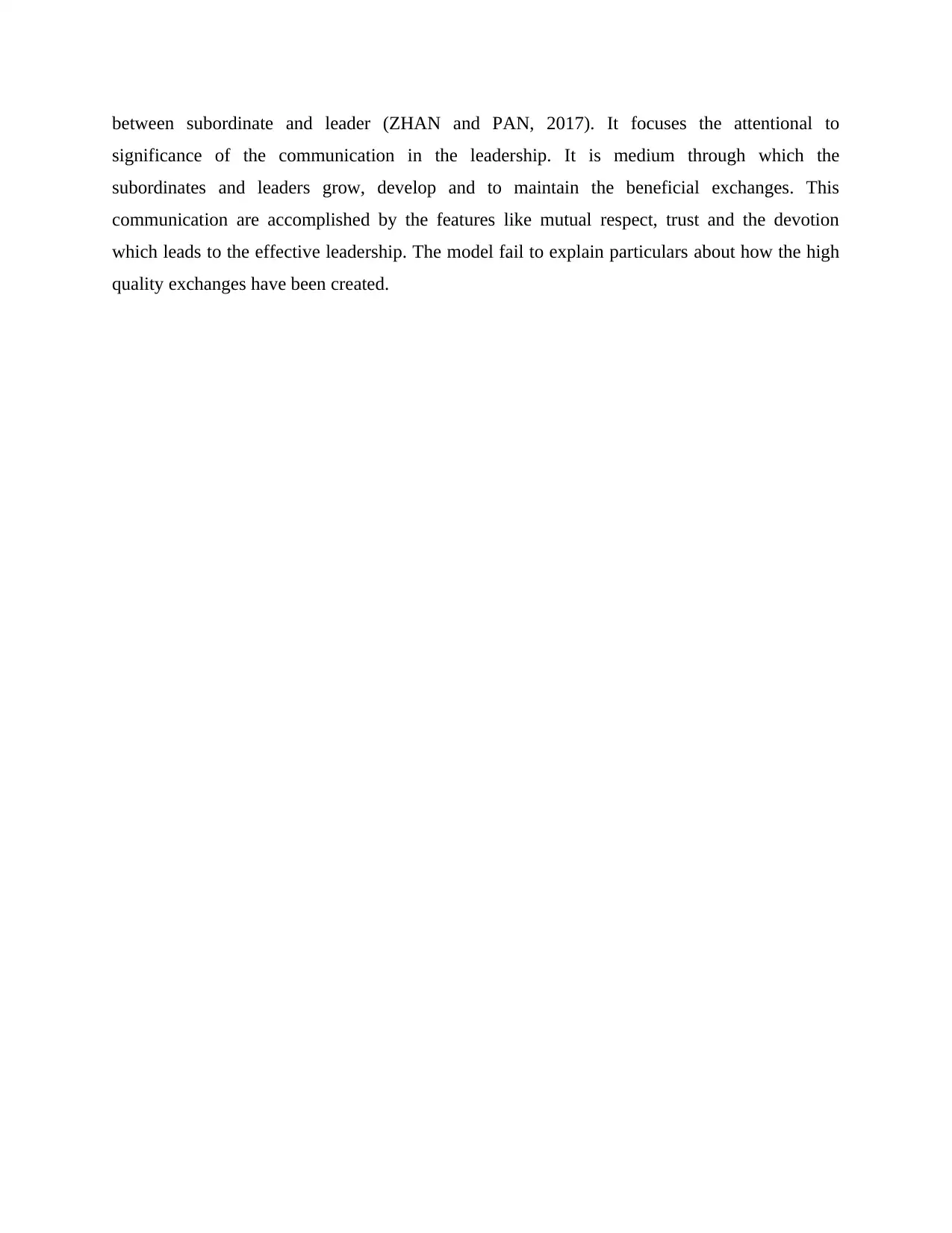
between subordinate and leader (ZHAN and PAN, 2017). It focuses the attentional to
significance of the communication in the leadership. It is medium through which the
subordinates and leaders grow, develop and to maintain the beneficial exchanges. This
communication are accomplished by the features like mutual respect, trust and the devotion
which leads to the effective leadership. The model fail to explain particulars about how the high
quality exchanges have been created.
significance of the communication in the leadership. It is medium through which the
subordinates and leaders grow, develop and to maintain the beneficial exchanges. This
communication are accomplished by the features like mutual respect, trust and the devotion
which leads to the effective leadership. The model fail to explain particulars about how the high
quality exchanges have been created.
Paraphrase This Document
Need a fresh take? Get an instant paraphrase of this document with our AI Paraphraser
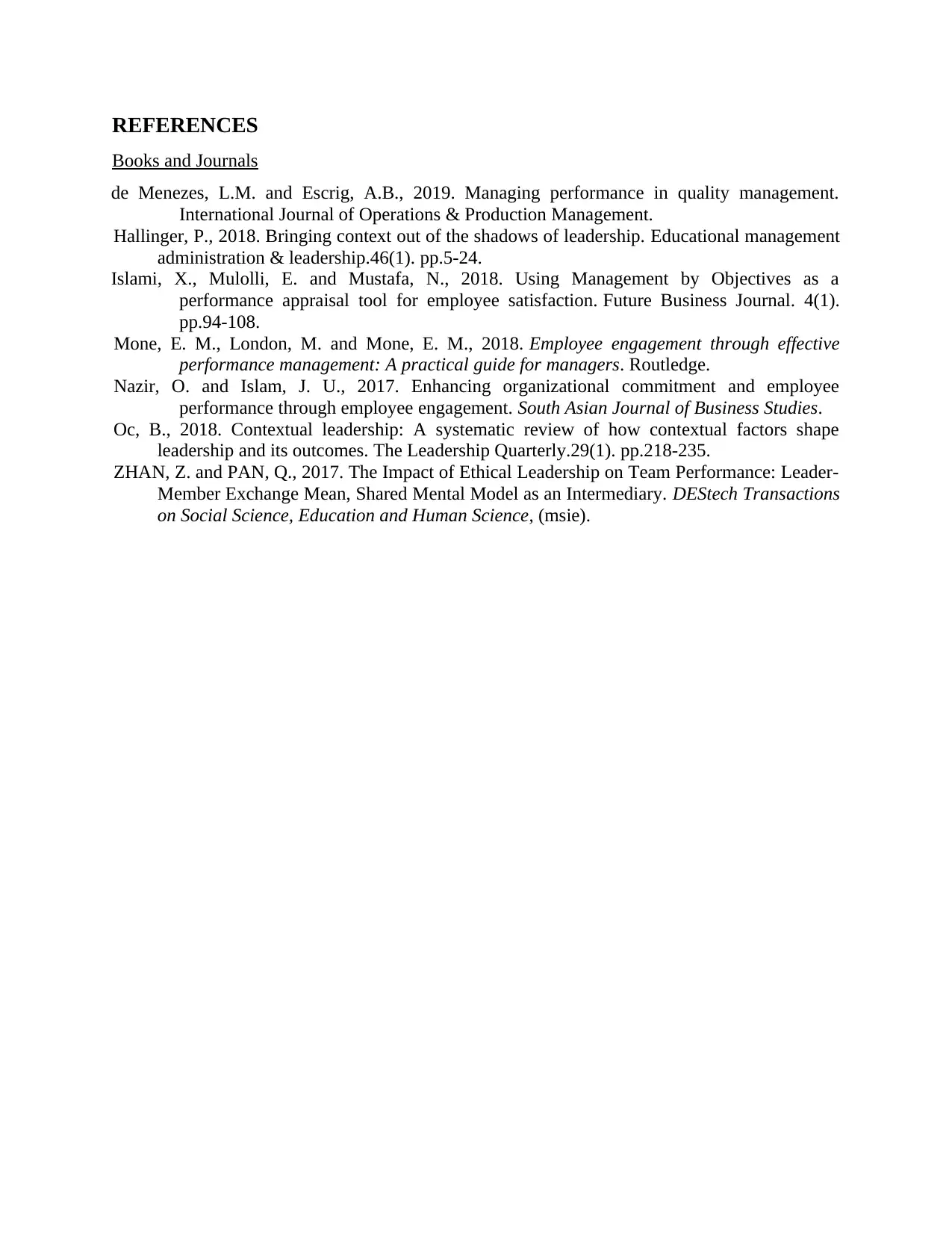
REFERENCES
Books and Journals
de Menezes, L.M. and Escrig, A.B., 2019. Managing performance in quality management.
International Journal of Operations & Production Management.
Hallinger, P., 2018. Bringing context out of the shadows of leadership. Educational management
administration & leadership.46(1). pp.5-24.
Islami, X., Mulolli, E. and Mustafa, N., 2018. Using Management by Objectives as a
performance appraisal tool for employee satisfaction. Future Business Journal. 4(1).
pp.94-108.
Mone, E. M., London, M. and Mone, E. M., 2018. Employee engagement through effective
performance management: A practical guide for managers. Routledge.
Nazir, O. and Islam, J. U., 2017. Enhancing organizational commitment and employee
performance through employee engagement. South Asian Journal of Business Studies.
Oc, B., 2018. Contextual leadership: A systematic review of how contextual factors shape
leadership and its outcomes. The Leadership Quarterly.29(1). pp.218-235.
ZHAN, Z. and PAN, Q., 2017. The Impact of Ethical Leadership on Team Performance: Leader-
Member Exchange Mean, Shared Mental Model as an Intermediary. DEStech Transactions
on Social Science, Education and Human Science, (msie).
Books and Journals
de Menezes, L.M. and Escrig, A.B., 2019. Managing performance in quality management.
International Journal of Operations & Production Management.
Hallinger, P., 2018. Bringing context out of the shadows of leadership. Educational management
administration & leadership.46(1). pp.5-24.
Islami, X., Mulolli, E. and Mustafa, N., 2018. Using Management by Objectives as a
performance appraisal tool for employee satisfaction. Future Business Journal. 4(1).
pp.94-108.
Mone, E. M., London, M. and Mone, E. M., 2018. Employee engagement through effective
performance management: A practical guide for managers. Routledge.
Nazir, O. and Islam, J. U., 2017. Enhancing organizational commitment and employee
performance through employee engagement. South Asian Journal of Business Studies.
Oc, B., 2018. Contextual leadership: A systematic review of how contextual factors shape
leadership and its outcomes. The Leadership Quarterly.29(1). pp.218-235.
ZHAN, Z. and PAN, Q., 2017. The Impact of Ethical Leadership on Team Performance: Leader-
Member Exchange Mean, Shared Mental Model as an Intermediary. DEStech Transactions
on Social Science, Education and Human Science, (msie).
1 out of 11
Related Documents
Your All-in-One AI-Powered Toolkit for Academic Success.
+13062052269
info@desklib.com
Available 24*7 on WhatsApp / Email
![[object Object]](/_next/static/media/star-bottom.7253800d.svg)
Unlock your academic potential
Copyright © 2020–2025 A2Z Services. All Rights Reserved. Developed and managed by ZUCOL.





